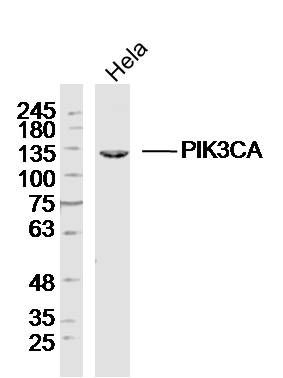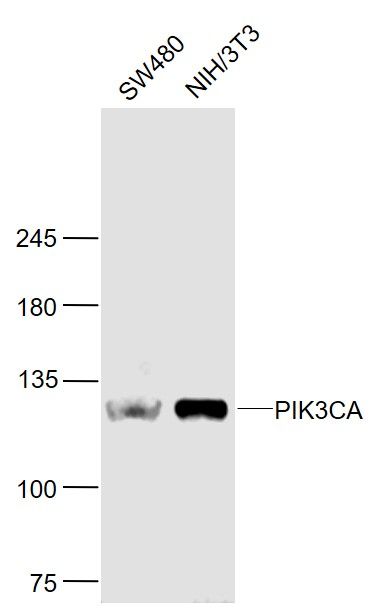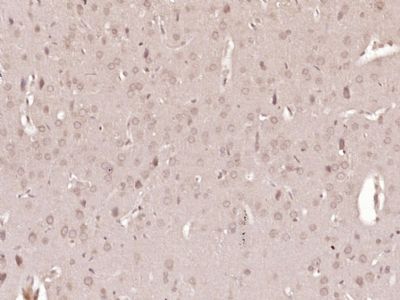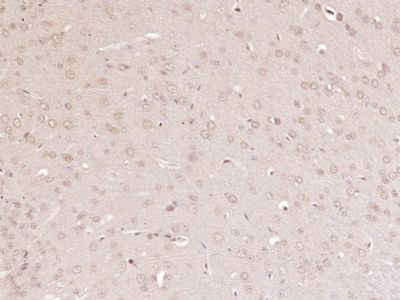上海细胞库
人源细胞系| 稳转细胞系| 基因敲除株| 基因点突变细胞株| 基因过表达细胞株| 重组细胞系| 猪的细胞系| 马细胞系| 兔的细胞系| 犬的细胞系| 山羊的细胞系| 鱼的细胞系| 猴的细胞系| 仓鼠的细胞系| 狗的细胞系| 牛的细胞| 大鼠细胞系| 小鼠细胞系| 其他细胞系|

| 规格 | 价格 | 库存 |
|---|---|---|
| 50ul | ¥ 980 | 200 |
| 100ul | ¥ 1680 | 200 |
| 200ul | ¥ 2480 | 200 |
| 中文名称 | 磷脂酰肌醇激酶催化亚单位A抗体 |
| 别 名 | PI3 kinase p110 subunit alpha; caPI3K; MGC142161; MGC142163; p110 alpha; p110 alpha; Phosphatidylinositol 3 kinase catalytic alpha polypeptide; Phosphatidylinositol 3 kinase catalytic 110 KD alpha; Phosphatidylinositol 4 5 bisphosphate 3 kinase catalytic subunit alpha isoform; Phosphoinositide 3 kinase catalytic alpha polypeptide; PI3 kinase p110 subunit alpha; PI3K; PI3KC A; PIK3C A; PK3CA; PtdIns 3 kinase p110; PI3-kinase P110α; PI3-kinase p110 subunit alpha; PI 3 Kinase catalytic subunit alpha; PK3CA_HUMAN; PI3 kinase P110α. |
研究领域肿瘤 细胞生物 免疫学 神经生物学 信号转导 细胞凋亡 激酶和磷酸酶
抗体来源Rabbit
克隆类型Polyclonal
交叉反应Human, Mouse, Rat, (predicted: Chicken, Cow, Rabbit, )
产品应用WB=1:500-2000 ELISA=1:500-1000 IHC-P=1:100-500 IHC-F=1:100-500 ICC=1:100-500 IF=1:100-500 (石蜡切片需做抗原修复)
not yet tested in other applications.
optimal dilutions/concentrations should be determined by the end user.
分 子 量117kDa
细胞定位细胞浆
性 状Liquid
浓 度1mg/ml
免 疫 原KLH conjugated synthetic peptide derived from human PI3KCA:961-1068/1068
亚 型IgG
纯化方法affinity purified by Protein A
储 存 液0.01M TBS(pH7.4) with 1% BSA, 0.03% Proclin300 and 50% Glycerol.
保存条件Shipped at 4℃. Store at -20 °C for one year. Avoid repeated freeze/thaw cycles.
PubMedPubMed
产品介绍PI3-Kinases (PI3-Ks) are a family of lipid kinases that are implicated in signal transduction. Phosphatidylinositol 3-kinase is composed of an 85 kDa regulatory subunit and a 110 kDa catalytic subunit. The p85 subunit localize PI3-K activity to the plasma membrane while the p110 subunit contains the catalytic domain of PI3-K which uses ATP to phosphorylate PtdIns, PtdIns4P and PtdInsP2. Four isoforms of p110 has been found; alpha, beta, gamma, and the delta subunit. The alpha isoform, also known as PI3KCA, is a transforming oncogene that was shown to have activating mutations in nine types of cancers such as colon, brain, breast and stomach.
Function:
PI3K that phosphorylates PtdIns, PtdIns4P and PtdIns(4,5)P2 to generate PIP3. PIP3 plays a key role by recruiting PH domain-containing proteins to the membrane, including AKT1 and PDPK1, activating signaling cascades involved in cell growth, survival, proliferation, motility and morphology. Participates in cellular signaling in response to various growth factors. Involved in the activation of AKT1 upon stimulation by receptor tyrosine kinases ligands such as EGF, insulin, IGF1, VEGFA and PDGF. Involved in signaling via insulin-receptor substrate proteins. Essential in endothelial cell migration during vascular development through VEGFA signaling, possibly by regulating RhoA activity. Required for lymphatic vasculature development, possibly by binding to RAS and by activation by EGF and FGF2, but not by PDGF. Regulates invadopodia formation in breast cancer cells through the PDPK1-AKT1 pathway. Participates in cardiomyogenesis in embryonic stem cells through a AKT1 pathway. Participates in vasculogenesis in embryonic stem cells through PDK1 and protein kinase C pathway. Has also serine-protein kinase activity: phosphorylates PIK3R1, EIF4EBP1 and HRAS.
Subunit:
Heterodimer of a catalytic subunit PIK3CA and a p85 regulatory subunit (PIK3R1, PIK3R2 or PIK3R3). Interacts with IRS1 in nuclear extracts. Interacts with RUFY3. Interacts with RASD2. Interacts with APPL1. Interacts with HRAS1 and KRAS. Interaction with HRAS1/KRAS is required for PI3K pathway signaling and cell proliferation stimulated by EGF and FGF2.
DISEASE:
Defects in PIK3CA are associated with colorectal cancer (CRC) [MIM:114500]. Defects in PIK3CA are a cause of susceptibility to breast cancer (BC) [MIM:114480]. A common malignancy originating from breast epithelial tissue. Breast neoplasms can be distinguished by their histologic pattern. Invasive ductal carcinoma is by far the most common type. Breast cancer is etiologically and genetically heterogeneous. Important genetic factors have been indicated by familial occurrence and bilateral involvement. Mutations at more than one locus can be involved in different families or even in the same case.
Defects in PIK3CA are a cause of susceptibility to ovarian cancer (OC) [MIM:167000]. Ovarian cancer common malignancy originating from ovarian tissue. Although many histologic types of ovarian neoplasms have been described, epithelial ovarian carcinoma is the most common form. Ovarian cancers are often asymptomatic and the recognized signs and symptoms, even of late-stage disease, are vague. Consequently, most patients are diagnosed with advanced disease.
Defects in PIK3CA may underlie hepatocellular carcinoma (HCC) [MIM:114550]. Defects in PIK3CA are a cause of keratosis seborrheic (KERSEB) [MIM:182000]. A common benign skin tumor. Seborrheic keratoses usually begin with the appearance of one or more sharply defined, light brown, flat macules. The lesions may be sparse or numerous. As they initially grow, they develop a velvety to finely verrucous surface, followed by an uneven warty surface with multiple plugged follicles and a dull or lackluster appearance.
Similarity:
Belongs to the PI3/PI4-kinase family.
Contains 1 C2 PI3K-type domain.
Contains 1 PI3K-ABD domain.
Contains 1 PI3K-RBD domain.
Contains 1 PI3K/PI4K domain.
Contains 1 PIK helical domain.
SWISS:
P42336
Gene ID:
5290
Database links:
Entrez Gene: 5290 Human
Omim: 171834 Human
SwissProt: P42336 Human
Unigene: 553498 Human
Unigene: 715194 Human
Unigene: 85701 Human
Important Note:
This product as supplied is intended for research use only, not for use in human, therapeutic or diagnostic applications.
磷脂酰肌醇激酶(P110α亚单位)
| 产品图片 |  Sample:Hela Cell(Human)Lysate at 40 ug Primary: Anti-PIK3CA(bs-2067R)at 1/300 dilution Secondary: IRDye800CW Goat Anti-Rabbit IgG at 1/20000 dilution Predicted band size: 117kD Observed band size: 120kD  Sample: SW480 (Human) Cell Lysate at 30 ug NIH/3T3(Mouse) Cell Lysate at 30 ug Primary: Anti- PIK3CA (bs-2067R) at 1/1000 dilution Secondary: IRDye800CW Goat Anti-Rabbit IgG at 1/20000 dilution Predicted band size: 117 kD Observed band size: 124 kD  Paraformaldehyde-fixed, paraffin embedded (Rat brain); Antigen retrieval by boiling in sodium citrate buffer (pH6.0) for 15min; Block endogenous peroxidase by 3% hydrogen peroxide for 20 minutes; Blocking buffer (normal goat serum) at 37°C for 30min; Antibody incubation with (PIK3CA) Polyclonal Antibody, Unconjugated (bs-2067R) at 1:400 overnight at 4°C, followed by operating according to SP Kit(Rabbit) (sp-0023) instructionsand DAB staining.  Paraformaldehyde-fixed, paraffin embedded (Mouse brain); Antigen retrieval by boiling in sodium citrate buffer (pH6.0) for 15min; Block endogenous peroxidase by 3% hydrogen peroxide for 20 minutes; Blocking buffer (normal goat serum) at 37°C for 30min; Antibody incubation with (PIK3CA) Polyclonal Antibody, Unconjugated (bs-2067R) at 1:400 overnight at 4°C, followed by operating according to SP Kit(Rabbit) (sp-0023) instructionsand DAB staining. |